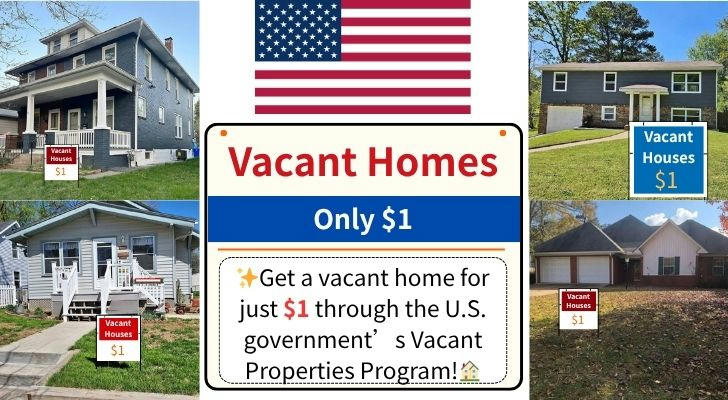🏠✨ How to Get Vacant Homes in the U.S.: Opportunities, Requirements & Real Case Sharing
🏚💭 Current Situation of Vacant Homes in the U.S.: How Many? What’s Going On?
📊 Latest data shows that there are approximately ~13 to 16 million~ 🏘 vacant homes across the country.
They’re scattered across 🌆 small towns, 🏙 city edges, and 🧱 old communities, mostly due to economic shifts and population flows.
🧰 Most of them need varying degrees of 🔧 repair, and while purchase entry is low 💵, making them livable still requires capital and time ⏳.

🏛️ Policies Related to Vacant Homes
| 📝 Key Aspect | Details |
|---|---|
| 💵 Down Payment | Starting from $1 |
| 🎁 Subsidy Amount | Up to $20,000~$25,000 + Up to $3,200 energy tax credit |
| 🧾 Repair Grant Method | Meet first-time buyer or low-income standard, submit plan 🧾, pass review ✅ |
| ⏳ Repair Timeline | 12~18 months |
| 🏡 Occupancy Requirement | Owner-occupied, held for a minimum time ⏳, not casually transferable 🚫 |
💵🏡 Vacant Home Programs (Buy from $1): Advantages, Subsidies & Requirements
These are designed to revitalize 💫 declining areas and re-energize neighborhoods 🏘. Some cities also provide 🎁 extra repair or purchase grants 💰.
✨ Advantages & Subsidies:
- 🏷️ From $1 you can obtain full ownership 🏠
- 🌱 Combine with up to $3,200 energy-efficient tax credit for eco-upgrades ♻️
- 👩💼 First-time buyers may receive up to $10,000+ as down payment or closing subsidy (amount often 3%-6% of price)
⚠️ Core Requirements:
- 🛠️ Repairs must be completed within 12~18 months, or ownership may be reclaimed 🔄
- 📋 A feasible renovation budget & timeline must be submitted
- 🏡 Buyer must live in the house for a required period, and not transfer freely
- 📵 Most programs are not for speculation — only open to owner-occupiers
💰 Cash Subsidies from Cities & States (Up to $25,000)
| 🧾 Type | 💰 Amount Range | 📋 Eligibility Conditions | 💬 Remarks |
|---|---|---|---|
| 🏡 Down Payment & Closing Grants | Up to $20,000~$25,000 | - First-time buyer or low-income - Submit repair/build plan 🏗 - Provide financial proof 💵 - Agree to occupy & retain property - Complete project in 12–18 months | 💡 Covers down payment, repairs & all related transaction expenses |
| 🎓 Homebuyer Education Aid | Typically a few thousand dollars | - May need to complete homebuyer education course 📘 - Must meet legal residency & income criteria | 🎯 Helps reduce buyer risk and improve understanding of the process |
🚀📋 Application Steps
- 🔍 Search for local policies & vacant home listings (official websites or social media groups)
- 📚 Understand eligibility, subsidies, repair scope & timeline
- 🧾 Prepare documents: ID, fund proof, renovation plan, and a timeline chart 🗂️
- 💡 Apply for subsidies (e.g. down payment, energy, repair) if applicable
- 📬 Submit application & wait for approval message ✅
- 📝 Finalize paperwork with local authority and begin construction or renovation 🔨
🧑🔧👩🌾 Real Case Studies
🏢❤ Case 1: Maria’s City Home Transformation
Maria secured an old property through a city housing initiative for $1 and received a $5,000 grant 💰.
She used it to repair the roof & plumbing, and also received $1,800 in eco-renovation tax credits 🌿.
💪 Within a year, she finished the work and now lives there while running a small family restaurant 🍽️. Her neighbors soon followed suit 🙌.
🌄🎉 Case 2: The Chen Family’s Small-Town New Life
The Chen family joined a rural incentive program and received land + a starter tool kit 🧰.
With an additional $3,000 repair subsidy from the town, they completed an eco-home within a year 🏡.
They now enjoy property ownership and have fully integrated into the community 💬👨👩👧👦.
🏡✨ Conclusion
“$1 home” programs + subsidies for 🛠 repair, 💵 down payment, and 🌱 energy efficiency significantly lower the cost and barrier to accessing and renovating vacant properties.
With ~careful planning~, ~commitment~, and the right support, even abandoned homes can shine again ✨, opening doors to a brand new lifestyle 🚪🌟.
